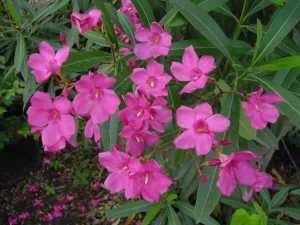Poisonous Plants Around Ponds
When you create a water garden around a pond, you will of course use plants that do well under home conditions. The selection of plant life is even more critical if you have fish in your pond. A pond is a small ecosystem and plants are a valuable part of this environment. Plants provide an important source of food for aquatic creatures; however, some plants are toxic to fish because they contain poisonous chemicals. If these toxic substances fall into the water, they can poison the fish.
Do you know which plants are poisonous to Koi and Goldfish? To provide just a few examples, water plants, such as Cardinal flower, Yew, Oleanders, Taro, Aloe leaves, and Yellow Star Thistle, may be toxic to fish. There are many more, so do your homework before choosing plants to surround your pond. The plants you choose to surround your pond should harmonize with the environment, and help balance the ecosystem; they should not add toxins to the water.
Trees
Trees can also be hazardous to fish, especially deciduous trees, so skip the deciduous trees near a Goldfish aquarium or a Koi pond. Depending on which direction they are located in relation to a pond; deciduous trees may be able to shed their leaves, berries and pollen into a pond from far away. Stay away from messy trees. Anytime a tree casts off leafage into a pond, there is a risk that the ecological system may be overloaded. Tress that can be hazardous around fish ponds, include the Rhodendron, Oleander, Yew, Poplar, Maple, and Oak.
Points to Remember
When you create a water garden around a pond, the plants you choose should balance the ecosystem and harmonize with the environment; they should not add toxins to the water. Never position poisonous pond plants next to your pond. If you think that you may have accidentally planted any type of poisonous growth, get rid of it immediately, and watch your fish keenly for a few days.
| Bushes and Trees | Toxic parts |
| Daphne mezereum | berries |
| Ginko | fruit |
| Laburnum anagyorides | pods and seeds |
| Privet | berries and leaves |
| Prunus (peaches, apricots, plums, cherries) | pits |
| Rhododendron | all parts |
| Taxus (yew) | seeds, needles, branches |
| Viburnum opulus (snowball bush) | berries |
| Vines | Toxic parts |
| Aristolochia durior (Dutchman’s Pipe) | all parts |
| Wisteria sinensis, W. floribunda | leaves and berries |
| Perennials | Toxic parts |
| Aconitum (Monkshood) | all parts |
| Arum maculatum (Wake Robin) A. italicum | berries |
| Brugmansia/Datura stramonia (Angel’s Trumpet) | all parts |
| Colchicum autumnale (Autumn Crocus) | all parts |
| Convollaria majalis (Lily of the Valley) | all parts (including water the flowers have been kept in) |
| Daffodil, Narcissus, Jonquil | all parts |
| Delphinium (Larkspur) | all parts |
| Digitalis purpurea (Foxglove) | foliage and seeds |
| Euphorbia (Snow on the Mountain) | sap |
| Hedera helix (English Ivy) | berries |
| Helleborus Niger (Christmas Rose) | all parts |
| Hyacinthus | bulbs |
| Lantana camara | unripe fruit |
| Milkweed | sap |
| Polygonatum (Solomon’s Seal) | same as Lily of the Valley |
| Rincinus communis (Castor Bean Plant) | seeds |
| The Nightshades | Poison: solamine |
| Atropa belladonna (Belladonna) | berries |
| Lycopersicon lycopersicum (tomato) | green fruit (if eaten in quantity) |
| Solanum dulcamara (Bittersweet) | unripe berries |
| Solanum nigrum (deadly nightshade) | berries |
| Solanum tuberosum (potato) | all parts but tubers; tubers if green |

